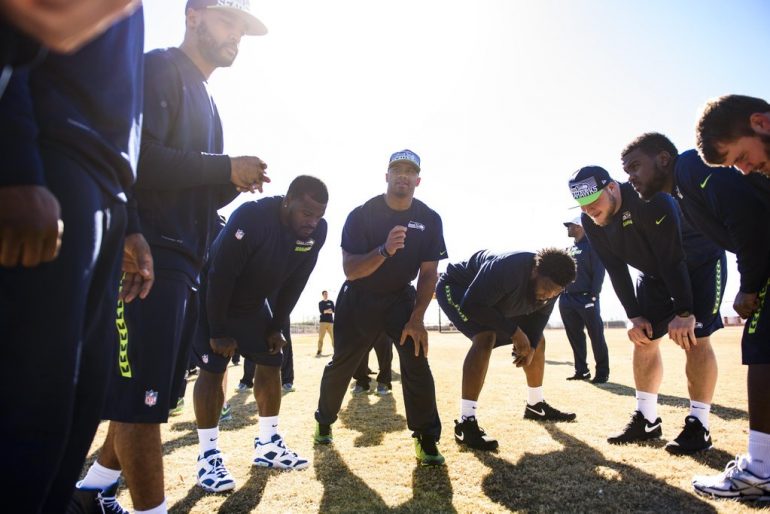

The 2013 Seattle Seahawks rode one of the best single-season defenses in history to a Super Bowl romp over Peyton Manning and the Denver Broncos. They were recognized at the time for being one of the best defenses ever, but a common critique was that it was just one season. The Chicago Bears in the 80s, the Baltimore Ravens at the turn of the century, the Steel Curtain Steelers of the 70s, and others, had sustained dominance. Obscured by an injury-ravaged finale of 2014, the Seahawks defense has now quietly put together a three-year stretch of dominance never before seen in the NFL.
The process
- 1984-1986 Chicago Bears
- 1969-1971 Minnesota Vikings
- 1999-2001 Baltimore Ravens
- 1974-1976 Pittsburgh Steelers
- 2001-2003 Tampa Bay Buccaneers
- 1990-1992 Philadelphia Eagles
Round 1: Absolute numbers
Absolute Points Per Game Over Three Years
| Rank | Years | Team | PPG |
| 1 | 1969-1971 | Minnesota Vikings | 9.9 |
| 2 | 1974-1976 | Pittsburgh Steelers | 11.6 |
| 3 | 1984-1986 | Chicago Bears | 13.2 |
| 4 | 1999-2001 | Baltimore Ravens | 14.7 |
| 5 | 2012-2014 | Seattle Seahawks | 15.2 |
| 6 | 2001-2003 | Tampa Bay Buccaneers | 15.4 |
| 7 | 1990-1992 | Philadelphia Eagles | 16.4 |
That Vikings defense was insane. Holding opponents under 10 points per game in any era is nuts. Pittsburgh is a few points behind, and the Bears are a few points behind the Steelers. The Ravens, Seahawks and Bucs are roughly equivalent and the Eagles bring up the rear. Now let’s look at yards allowed:
Absolute Yards Per Game Over Three Years
| Rank | Years | Team | YPG |
| 1 | 1969-1971 | Minnesota Vikings | 212.6 |
| 2 | 1974-1976 | Pittsburgh Steelers | 239.5 |
| 3 | 1984-1986 | Chicago Bears | 252.7 |
| 4 | 1990-1992 | Philadelphia Eagles | 262.9 |
| 5 | 1999-2001 | Baltimore Ravens | 263.2 |
| 6 | 2001-2003 | Tampa Bay Buccaneers | 274.2 |
| 7 | 2012-2014 | Seattle Seahawks | 282.3 |
If you had not already decided this is a biased article written by a homer blogger, the thought certainly has to cross your mind after seeing the Seahawks at the bottom of this list. How else could anyone come to the conclusion that this Seahawks defense is the best ever? Hold that thought as we start to examine how these defenses performed relative to the era in which they played.
Round 2: League rankings
Average NFL Rank In Points Per Game Over Three Years
| Rank | Years | Team | Avg PPG Rank |
| 1 | 2012-2014 | Seattle Seahawks | 1.0 |
| 2 | 1969-1971 | Minnesota Vikings | 1.0 |
| 3 | 1984-1986 | Chicago Bears | 1.7 |
| 4 | 1974-1976 | Pittsburgh Steelers | 1.7 |
| 5 | 1999-2001 | Baltimore Ravens | 3.7 |
| 6 | 2001-2003 | Tampa Bay Buccaneers | 4.3 |
| 7 | 1990-1992 | Philadelphia Eagles | 4.3 |
Seattle has ranked #1 in the NFL in points allowed in each of the last three seasons. The only other team since the AFL/NFL merger to accomplish that feat was the 1969-71 Vikings (Note: I’m grandfathering in the Vikings despite the streak starting before the merger).
The Seahawks have a chance to become the first team since the merger to rank #1 in points allowed for four straight seasons
All of these teams averaged a top five ranking in this category for a three-year stretch, which is fantastic. Seattle and Minnesota’s performance relative to their peers stands out.
Average NFL Rank In Yards Per Game Over Three Years
| Rank | Years | Team | Avg YPG Rank |
| 1 | 1984-1986 | Chicago Bears | 1.0 |
| 2 | 1969-1971 | Minnesota Vikings | 1.3 |
| 3 | 2012-2014 | Seattle Seahawks | 2.0 |
| 4 | 1999-2001 | Baltimore Ravens | 2.0 |
| 5 | 1974-1976 | Pittsburgh Steelers | 2.0 |
| 6 | 2001-2003 | Tampa Bay Buccaneers | 4.0 |
| 7 | 1990-1992 | Philadelphia Eagles | 6.3 |
Chicago is the only team in NFL history to go three straight years ranked at the top of the league in yards allowed. Seattle has done it for two straight years, and could become just the second team to accomplish that feat should they lead the league again this season. Even if points allowed is a far more important measure of a defense, the Bears accomplishment in this area is historically unparalleled.
Round 3: Standing out from the crowd
Standard Deviations From League Average In Points Per Game Over Three Years
| Rank | Years | Team | Avg Def PPG Allowed | PPG Std Dev |
| 1 | 2012-2014 | Seattle Seahawks | 22.9 | -2.90 |
| 2 | 1984-1986 | Chicago Bears | 21.1 | -2.49 |
| 3 | 1969-1971 | Minnesota Vikings | 19.3 | -2.49 |
| 4 | 1999-2001 | Baltimore Ravens | 20.6 | -2.18 |
| 5 | 2001-2003 | Tampa Bay Buccaneers | 20.9 | -2.09 |
| 6 | 1974-1976 | Pittsburgh Steelers | 19.0 | -2.08 |
| 7 | 1990-1992 | Philadelphia Eagles | 19.3 | -1.03 |
Offenses are scoring more than ever before. Seattle is playing in an era where teams are scoring nearly 23 ppg, which makes their 15.2 ppg allowed far more impressive than when it is examined in isolation via absolute numbers as we did in Round 1. In fact, they are lapping the competition in the most important measure covered here.
Seattle is nearly three standard deviations better preventing scoring than the rest of NFL defenses in their era. That is a mind-boggling number and significantly ahead of the rest of history’s best defenses.
A one-hit wonder team like the Eagles is exposed by this method of evaluation. They do not really belong in this list. They were not even the best performers in this category during this stretch of time. The 1990-92 New Orleans Saints were -1.78 standard deviations better than the league average. The San Francisco 49ers and Washington Redskins also bested the Eagles in this measure.
It is hard to find teams that are two standard deviations better than the league average. These are the best defenses to ever play, and three of them are right around two standard deviations better than average defenses in their era. Seattle pushing up near three, and being almost a half-a-deviation better than the nearest competitor speaks volumes about what the Seahawks are doing in a fantasy football-driven era of the NFL.
Standard Deviations From League Average In Yards Per Game Over Three Years
| Rank | Years | Team | Avg Def YPG Allowed | YPG Std Dev |
| 1 | 1984-1986 | Chicago Bears | 327.8 | -3.07 |
| 2 | 2012-2014 | Seattle Seahawks | 347.9 | -2.98 |
| 3 | 1969-1971 | Minnesota Vikings | 287.3 | -2.45 |
| 4 | 1999-2001 | Baltimore Ravens | 318.6 | -2.34 |
| 5 | 2001-2003 | Tampa Bay Buccaneers | 320.8 | -2.09 |
| 6 | 1974-1976 | Pittsburgh Steelers | 297.6 | -2.02 |
| 7 | 1990-1992 | Philadelphia Eagles | 304.5 | -1.89 |
Chicago breaks the sound barrier by besting the league averaged in their era by over three standard deviations in yards allowed. But Seattle is right there with them at just a smidge below three. Both teams are far ahead of their nearest competitor, the Vikings.
Again, yards allowed is not nearly as important as points allowed, but it represents a level of dominance over an opponent that deserves recognition.
At this point, only three defenses merit consideration for the best of all-time: the Bears, Seahawks, and Vikings. The rest of these defenses were fantastic and dominant, but simply did not stand out the same way the top three did relative to their peers.
Picking the best
The Seahawks will now set their sights on a fourth straight season of excellence. There is reason to believe this could be the best defense they have fielded yet given their young depth on the defensive line and maturation of their linebacking corps. Another dominant season, another trip to the Super Bowl, and another ring would put an exclamation point on what has already been a historically great run of defense.

